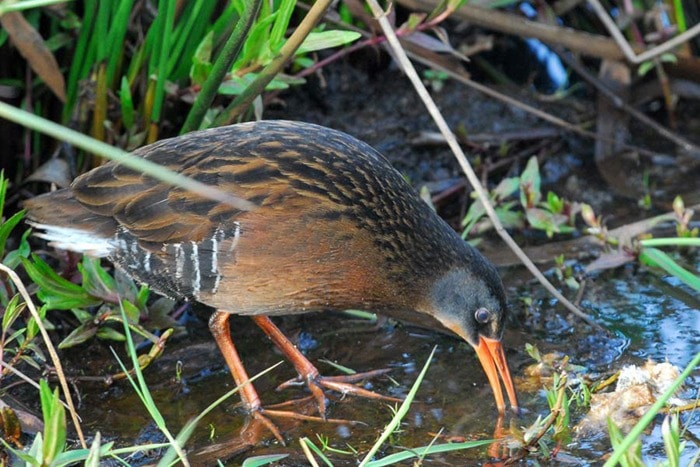Elusive and secretive, the Virginia rail the most common of the nine rail species found in North America.
Even some of the most avid, patient birders have never recorded a sighting of this intriguing marsh bird. On a recent visit to the George Reifel bird sanctuary in Delta, I kept my eyes peeled in hopes of spotting one, but no such luck.
This sanctuary in the Fraser River delta is a major stopover for the Pacific Flyway migration. A combination of saltwater marshes, dikes and freshwater wetlands; it is also the winter feeding grounds for many species of migratory birds. It is well worth a visit and a great place for avid birders and photographers.
Our local populations of rails are mainly migratory, preferring to walk through marshy vegetation when they are summer residents. Although they are weak fliers, rails have the highest ratio of leg muscles to flight muscles of any other bird, and are expert runners.
These birds have a number of special features that enable them to live in a very specific environment.
"Thin as a rail" is an expression derived from the way a rail can compress its body laterally using flexible vertebrae, allowing it to squeeze between closely knit vegetation. Specially adapted head feathers can withstand the wear and tear from pushing their way through sharp reeds and grasses.
They blend in perfectly with their marshy habitat. Long reddish-brown legs and stand on large wide feet that can propel them across the marshy vegetation with barely a ripple.
Rails are monogamous birds when it comes to a relationship. The male runs around the female with raised wings and a twitching tail stopping to bow in front of her; if she returns the bow he knows his advances have been accepted.
Dense freshwater marshes are preferred for nesting; nests are fashioned from reeds and grasses making a raised basket atop the aquatic vegetation. Fiercely protective of their nests and young, the pair will build decoy nests to draw predators away from the young.
In the past few weeks there have been sightings of rails around dusk, as they prefer to move when they are least visible; this was the time a rail unfortunately ended up on a driveway in the Puntledge River area, maybe mistaking the driveway for the water.
Virginia rails migrate south as far as Guatemala, a feat that always amazes me with so many hazards along the way.
These rails fly at night at a lower elevation than many other species and can be disorientated by low clouds and fog, this may have been the case with the driveway rail, as it had sustained a head injury and did not survive.
Water birds and ducks are very hard to rehabilitate due to their feeding habits and specialized habitat so where possible we try and return them as soon as they are strong enough, giving them the best chance of survival.
Keep an eye out for migrating birds. The last few storms are bound to have an impact on the migration. Remember, the Comox Valley is an extremely important stop over for many species as they refuel to continue their arduous trek south.
Please continue to be vigilant when driving on dark wet nights. Deer encounters are still a problem and will be more so when daylight savings time comes into effect.
To call for advice on wildlife issues or to report an injured bird or animal, call toll free at 1-800-304-9968, for more information please visit www.wingtips.org.
Sandy Fairfield is the educational co-ordinator for the Mountainaire Avian Rescue Society (MARS). The MARS column appears every second Thursday.
